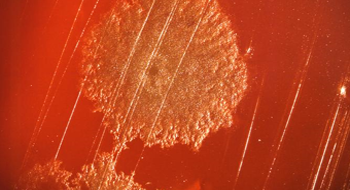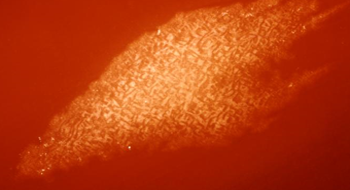



Botulism is a rare paralytic disease caused by botulinum neurotoxin (BT), a protein produced by the soil bacteria Clostridium botulinum. Different strains of the bacteria make different types of toxin. However, only four of the seven known BT types (A, B, E, and F) cause human botulism. One of the most deadly known toxins, estimates indicate that approximately 70 one millionths of a gram can kill an average adult. However, of the approximate 140 cases per year in the U.S., there are usually only 1-3 deaths.
Poisoning from BT can occur in several ways, the frequency of which varies from year to year. Approximately two thirds of all infections are caused by consumption of bacterial spores, which can turn into bacteria. This type of infection is commonly referred to as infant botulism because it primarily affects babies fed contaminated honey. Consumption of food contaminated with the toxin or bacteria is responsible for less than a quarter of all cases. Finally, bacterial infection of a wound causes a handful of cases each year. There are a few isolated examples of aerosolized BT causing illness in researchers who accidentally inhaled it. This, however, does not occur naturally.
In theory, BT can be used as a biological weapon by contaminating food or drink with the toxin or the bacteria. It is also possible to weaponize BT as an aerosol. When C. botulinum is growing in ideal conditions, it produces toxin, which can be purified. However, processing the toxin into an aerosol is extremely difficult even for those with microbiology and bioweapons experience.
The toxin affects the connections between nerves and the muscles they control. It does this by interfering with the release of the chemical messenger, acetylcholine, which the nerve uses to signal the muscle to contract. After entering the cell, the toxin physically destroys proteins required for the release of acetylcholine, effectively silencing the nerve.
The main treatment for botulism is antitoxins, which are antibodies that bind to BT and prevent it from affecting nerve cells. Once the toxin is bound to the cell, antitoxin is ineffective against it, making rapid diagnosis critical to preventing further paralysis. Antibiotics are also administered to kill the bacteria. The currently available antitoxins are isolated from horses and can cause adverse reactions in people. Doctors must request antitoxin from the CDC to treat patients. The antitoxin effective against BT types A and B is licensed by the FDA. The U.S. Army also has an effective antitoxin, but it is not FDA approved. Finally, a vaccine against BT is given to U.S. military troops and lab personnel at high risk of exposure. Extensive paralysis caused by the toxin may require assisted breathing, feeding and physical therapy for months while new nerves connect to paralyzed muscles.
Within 18-36 hours after ingestion of contaminated food or 12-80 hours after inhalation of the toxin the first symptoms appear , but they can occur as early as 6 hours or as late as 10 days from the time of initial exposure depending upon the amount of toxin or bacteria present. This initially causes slurred speech, dry mouth, double and blurred vision, as well as breathing and swallowing difficulty. The effects slowly progress down the body symmetrically, weakening it, reducing muscle reflexes, and paralyzing the limbs. Botulism-related deaths are caused by paralysis of muscles required for breathing including the diaphragm.
WHO, CDC, FDA , Medline Plus, NIAID, Center for Biosecurity at UPMC, Arnon SS, Schechter R, et al. Botulinum Toxin as a Biological Weapon: Medical and Public Health Management. JAMA 2001;285:1059-1070